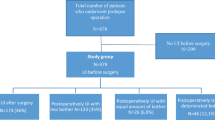Abstract
Introduction and hypothesis
To investigate the prevalence and risk factors of de novo urinary incontinence (UI) after pelvic organ prolapse (POP) surgery.
Methods
Data from 2013 to 2016 were collected from the Danish Urogynecological Database, where registration for any urogynecological procedure performed in Denmark is mandatory. Inclusion criteria were urinary continent women who underwent POP surgery. A woman was urinary continent if her total score on the International Consultation on Incontinence Questionnaire-Urinary Incontinence-short form (ICIQ-UI-sf) was 0 and she answered ‘never’ to ‘When does urine leak?’ Postoperatively, the women were categorized as continent or women with stress urinary incontinence (SUI), urgency urinary incontinence (UUI), mixed urinary incontinence (MUI) or undefined UI. We performed multivariate logistic regression analyses. The included parameters were preoperative POP stage (POP-Q), compartment, BMI and age. P values < 0.05 were considered statistically significant.
Results
We included 1198 women. The risk of de novo UI was 15%; 45% had SUI, 30% had UUI, 16% had MUI, and 10% had undefined UI. BMI was highly associated with de novo UI; the risk was 12% for women with BMI < 25, 16% for women with BMI 25 – < 30 and 23% for women with BMI ≥ 30. Age, compartment and POP stage were not associated with de novo UI.
Conclusions
The prevalence of de novo UI is the same regardless of the involved compartment/s and POP stage. BMI is significantly associated with de novo UI; twice as many women with BMI ≥ 30 had de novo UI compared with women with BMI < 25.
Similar content being viewed by others
References
Mouritsen L, Larsen JP. Symptoms, bother and POPQ in women referred with pelvic organ prolapse. Int Urogynecol J Pelvic Floor Dysfunct. 2003;14(2):122–7.
Svenningsen R, Borstad E, Spydslaug AE, Sandvik L, Staff AC. Occult incontinence as predictor for postoperative stress urinary incontinence following pelvic organ prolapse surgery. Int Urogynecology J. 2012;23(7):843–9.
Alas AN, Chinthakanan O, Espaillat L, Plowright L, Davila GW, Aguilar VC. De novo stress urinary incontinence after pelvic organ prolapse surgery in women without occult incontinence. Int Urogynecology J. 2017;28(4):583–90.
Ellström Engh AM, Ekeryd A, Magnusson Å, Olsson I, Otterlind L, Tobiasson G. Can de novo stress incontinence after anterior wall repair be predicted? Acta Obstet Gynecol Scand. 2011;90(5):488–93.
Lensen EJM, Withagen MIJ, Kluivers KB, Milani AL, Vierhout ME. Urinary incontinence after surgery for pelvic organ prolapse. Neurourol Urodyn. 2013;32(5):455–9.
Ennemoser S, Schönfeld M, von Bodungen V, Dian D, Friese K, Jundt K. Clinical relevance of occult stress urinary incontinence (OSUI) following vaginal prolapse surgery: long-term follow-up. Int Urogynecology J. 2012;23(7):851–5.
Brubaker L, Cundiff GW, Fine P, Nygaard I, Richter HE, Visco AG, et al. Abdominal sacrocolpopexy with Burch colposuspension to reduce urinary stress incontinence. N Engl J Med. 2006;354(15):1557–66.
Jundt K, Wagner S, von Bodungen V, Friese K, Peschers U. Occult incontinence in women with pelvic organ prolapse—does it matter? Eur J Med Res. 2010;15(3):112–6.
Guldberg R, Brostrøm S, Hansen JK, Kærlev L, Gradel KO, Nørgård BM, et al. The Danish Urogynaecological database: establishment, completeness and validity. Int Urogynecology J. 2013;24(6):983–90.
Årsrapport nr 11. For Dugabase [internet]. [cited 2019 Feb 18]. Available from: http://dugabase.dk/wp_dugabase/wp-content/uploads/2013/10/DugaBase_%C3%85RSRAPPORT-2016-FINAL.pdf.
Ng M, Fleming T, Robinson M, Thomson B, Graetz N, Margono C, et al. Global, regional, and national prevalence of overweight and obesity in children and adults during 1980–2013: a systematic analysis for the Global Burden of Disease Study 2013. Lancet Lond Engl. 2014 Aug 30;384(9945):766–81.
Osborn DJ, Strain M, Gomelsky A, Rothschild J, Dmochowski R. Obesity and female stress urinary incontinence. Urology. 2013;82(4):759–63.
Khayyami Y, Lose G, Klarskov N. The urethral closure mechanism is deteriorated after anterior colporrhaphy. Int Urogynecology J. 2018;29(9):1311–6.
Author information
Authors and Affiliations
Corresponding author
Ethics declarations
Conflict of interest
Yasmine Khayyami has no disclosures. Marlene Elmelund has received paid travel expenses and honoraria from Contura outside the submitted work. Gunnar Lose has received honoraria as a consultant for Contura outside the submitted work. Niels Klarskov has received paid travel expenses from Contura outside the submitted work.
Additional information
Publisher’s note
Springer Nature remains neutral with regard to jurisdictional claims in published maps and institutional affiliations.
Rights and permissions
About this article
Cite this article
Khayyami, Y., Elmelund, M., Lose, G. et al. De novo urinary incontinence after pelvic organ prolapse surgery—a national database study. Int Urogynecol J 31, 305–308 (2020). https://doi.org/10.1007/s00192-019-04041-5
Received:
Accepted:
Published:
Issue Date:
DOI: https://doi.org/10.1007/s00192-019-04041-5



